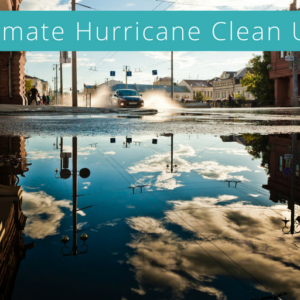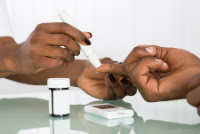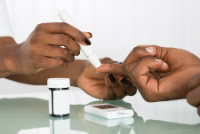Your Ultimate Hurricane Clean Up Guide

Your Ultimate Hurricane Clean Up Guide – From Your Home to Your Body
Now that most of Hurricane Harvey’s and Irma’s waters have subsided and we are left to assess the damage, an important time presents itself. Hurricane clean-up is more than gathering debris and clearing out the mud that remains, it involves protecting ourselves from current and future threats. This most certainly includes invisible killers released by the toxic mold that creeps into water damaged buildings and wreaks havoc on our health.
When we think of hurricane clean-up, many don’t realize the significance mold has on our health. It’s hard to keep this invisible threat at the forefront of our efforts when there’s so much wreckage in our path, but we must.
Mold remediation is possibly the most important of aspect of hurricane clean up.
If mold remediation is not done properly and regularly checked for over the years, you run the risk of making yourself and your family very, very sick. As a Functional Medicine physician who helps people with serious chronic diseases I see this all too often!
Now that you’re safe from the immediate dangers of the storm, I cannot emphasize enough the importance of cleaning up from this hurricane with mold prevention and remediation as priority number one.
Is mold a new health concern?
Mold has always played a role in human health, however it’s only in the past few decades that we’ve started building houses out of what’s essentially paper. Drywall and wood are ideal hosts for robust mold blooms.
All mold requires moisture to grow and thrive. It’s this combination of perfect host materials and high moisture content due to flooding that makes hurricane damaged building a breeding ground for toxic mold. Unfortunately, the Texas and Florida heat exacerbates this situation.
How mold works
Mold’s role in nature is that of a decomposer. Mold grows on dead organic matter, such as leaves and trees, breaking it down. Mold reproduces through the release of tiny airborne spores. These spores are invisible and can be toxic.
Mold toxins have been linked to a whole host of medical issues including autoimmune diseases, such as rheumatoid arthritis, DNA damage, neurotoxicity, and myelin breakdown which can contribute to Alzheimer’s, Parkinson’s, and multiple sclerosis. In fact, Inhalational Alzheimer’s Disease (IAD) is a subtype of Alzheimer’s caused by biotoxins, which has only recently been identified.
The mitochondria of our cells evolved from bacteria, and bacteria’s natural enemy is mold and the toxins mold releases. So, it makes sense that certain molds we encounter would carry the unique ability to damage our mitochondria. It’s how we develop antibiotics (think Penicillin). We use mold to create antibiotics responsible for killing harmful bacteria (and sometimes inadvertently we end up also killing the good bacteria).
Properly cleaning up after a hurricane is critical to preventing damaging mold from growing in your home. It may seem daunting to take the extra steps necessary for killing and preventing future mold growth, but your health and the health of your family depends on it.
Symptoms of mold exposure
Mold can move in surprisingly quick after a flood. In fact, it can already be there when you start the initial work on your house, only a couple of days after the storm.
The symptoms of mold exposure include debilitating fatigue and mood swings, so it could be possible to mistake mold exposure symptoms due to the exhaustion as well as the emotionally taxing situation you’re in, but paying close attention to your new symptoms is the key. The signs and symptoms of mold exposure can include:
- Chronic fatigue
- Muscle weakness and pain
- Anxiety
- Mood swings
- Difficulty concentrating
- Poor memory
- Chronic headaches
- Bruising
- Nosebleeds
- Vertigo
- Stiff joints
- Tingly legs and arms
- Insatiable thirst
- Metallic taste
- New allergies
- Rheumatoid arthritis
- Crohn’s disease
- Hashimoto’s thyroiditis
- Other Autoimmune disease(s)
The tricky thing about mold is its symptoms present differently for everyone. This is why it is so hard to diagnose early.
To further complicate matters, there’s an actual gene that 25 percent of the population carries which makes them incredibly sensitive to mold. The HLA-DR gene prevents the individual’s body from successfully ridding itself of toxins. Think of the canaries in a coal mine! I should know as I surely am one!
Often, a family doesn’t realize there’s mold in the house until a person with this gene becomes very ill. Whether or not you have the HLA-DR gene, you should thoroughly clean your house using proper mold remediation protocol. Just because you’re not extra sensitive to mold toxins doesn’t mean you aren’t negatively impacted by them, it just might take you longer for you to notice.
Cleaning up after a flood
Cleaning up after a flood should be taken very seriously. There’s a chance mold has already moved into your home. As you rip out drywall and get your home ready to rebuild, it’s safest to assume mold has already moved in and take necessary precautions.
Also, if you are planning on rebuilding, you should have your home tested by a qualified mold inspector. You’ll need an ERMI test done on your house before any remodeling begins or you run the risk of covering up mold growth.
Remember, you are cleaning up to prevent the growth of a substance that can cause you and your loved ones’ serious long term illnesses, and it takes less than a day for mold to start growing. Be vigilant.
Here’s what you should do when cleaning up a flooded building:
- Wear a Tyvek suit and face mask when cleaning up. You should use either a full-face mask or a half-face mask with goggles. Moldex makes masks specifically for mold clean up.
- Everything your Tyvek suit touches when you leave the house could become contaminated – this includes your car. Remove your Tyvek suit and throw it away or leave it outside the house each time you leave the contaminated building.
- If you start feeling ill, tired, crave sugar or are overly emotional while you’re cleaning, you should leave the house immediately and upgrade your protective equipment before returning to work.
- You’ll need to clean everything with a suitable cleaner (NOT bleach) and follow up with an encapsulant. Encapsulants are cleaning products with fungicides that prevent mold from coming back.
Porous materials, such as wood, are of greater concern when cleaning, but for the sake of simplicity I’m going to recommend you use the same cleaning procedure for all surfaces, and this does NOT include bleach. Bleach won’t kill the mold in porous materials and it will only cause future mold to grow back stronger.
Instead do this:
A formula I have used in my home in the past when I’ve had minor leaks:
- 1 gallon hot water
- ½ cup white vinegar
- 1 cup Borax
Mix well. Put above mixture in a spray bottle. Add 10-15 drops of Melaleuca essential oil to the spray bottle each time you refill it. Shake well and spray on affected surfaces.
(Consider diffusing clove, melaleuca, eucalyptus, lemon, and cinnamon essential oils in multiple diffusers throughout your home)
-
Follow up with an encapsulant, such as Caliwel or Concrobium.
- Careful not to cross-contaminate. This means anything from your flooded home should not be taken into a clean environment (your car).
- You’ll need to seriously consider what’s worth putting your health in danger as you go through all the porous items from your flooded home. This means clothing, curtains, books, furniture, bedding, photos and more.
Fabric should be thrown away when possible. If you must keep something, have it dry cleaned. Photos should be laminated or reprinted.
After you’ve gone through this process and before you begin remodeling, you should have an ERMI test done by a mold professional.
You should also have your home (and yourself) tested for mold allergy as well as mold toxins (known as mycotoxins) over the next year or two – possibly longer, especially if vague and troublesome symptoms persist.
Supporting your immune system during flood clean up
While you’re cleaning up a flood damaged home, you should try to support your immune system as best as you can. Your body is going to be exposed to all kinds of chemicals, toxins, and potentially mold, so it will need any extra support you can offer.
The four immune system supporting recommendations I suggest during clean up include:
- An immune boosting diet
- Reducing your toxic burden
- Supplementation
- Be good to yourself/stress reduction
First, I recommend an immune boosting diet.
This means a nutrient-dense diet of healthy fats, proteins, and plenty of vegetables.
Avoid sugar and carbs because they promote inflammation and make it harder for your mitochondria and immune system to do their jobs. Instead healthy fats and proteins should be your main source of fuel.
Also, I recommend avoiding alcohol during clean-up because your liver and immune system need to be freed up to detox your body from more important toxins.
Second, reduce your toxic burden.
Outside of home clean-up, consider other sources of toxins you’d benefit from removing from your life. You can reduce toxin burden by eliminating items such as:
- Harmful cleaning products
- Toxin-containing personal care products
- Fish high in mercury and other metals
- Paints with VOCs
- Non-stick pans
- Fried and charred food
- Artificial sweeteners
- BPA-containing plastics
- Metal dental fillings
Yes, some of these are for later but I just want you to have a full resource.
As a side note, candida overgrowth in your body increases your toxic burden too. I often get asked if candida or yeast overgrowth is because of mold, so clarifying here:
If you have symptoms of candida overgrowth, it is not due to inhaling it in your home air. You may have toxic mold in your house but the air in your home does not typically contain much Candida albicans. However, exposure to mold can seriously weaken the immune system making our body more prone to candida flares within our digestive system (candida is present in small amounts in all of our gastrointestinal systems), which when severe can lead to systemic and widespread symptoms in the body.
In addition, mold exposure can make one more sensitive to all kinds of fungi (candida is a fungus) and mold. Developing an allergy to mold leads to hypersensitivity to candida and starts a viscous cycle of inflammation and immune system dysfunction with far reaching consequences.
As a free gift please access my Candida Control Foods & Remedies Guide. My hope is that in it you will find some useful strategies to prevent, and get rid of candida overgrowth and the chronic symptoms it can cause. Supporting your body with these strategies will help in re-balancing your immune system while you deal with the effects of water damage.
Third, I recommend adding immune supporting supplements to your diet.
Immune system boosting supplements include:
- A balanced multivitamin. Choose one with iron if you are a menstruating woman or have a known iron deficiency. Choose iron free for everyone else.
- Vitamin B complex (for methylation support)
- Vitamin C (with bioflavonoids – needed for a healthy immune system)
- Vitamin D (to support the immune system and protect against disease development)
- Vitamin E (defense against free radicals). Choose one with mixed tocopherols
- Probiotics (improves gut health and reduces inflammation). Choose ones with multiple strains of beneficial bacteria.
- Glutathione (master antioxidant of the body, aids in defense against free radicals). Choose easily bioavailable forms like S-acetyl glutathione or precursors of glutathione like N acetyl cysteine (NAC).
- Zinc (important for thyroid and immune system health)
- Omega 3 in a balanced ratio (reduces inflammation, immune support) with some beneficial omega 6s and 9s in your diet as well. Here is an article I wrote about Omegas.
- Magnesium citrate (important for overall health and prevents constipation). During this time it’s super important your body is able to detoxify efficiently, which is why it’s critical you avoid constipation at all costs.
- If you have 2-3 bowel movements a day already, you can choose a chelated form of Magnesium glycinate instead. Most of us are low in magnesium and it can be a crucial nutrient especially during stressful periods.
- Selenium (reduces inflammation, supports thyroid function, and reduces free radical stress) You can get selenium from a good quality multivitamin, and also eat a couple of brazil nuts daily.
- liver detox support with a combination formula with milk thistle, n-acetylcysteine, alpha lipoic acid, calcium-D-glucarate, turmeric, resveratrol, methylated B vitamins, and essential trace minerals etc.
- hormonal detox support– Yes, your own hormones can become toxins if not eliminated properly from the body.
- Activated charcoal (defense against free radicals)
I added links to supplements I’ve formulated over the years because I know they are of the highest-quality, but honestly please buy these from any source your know to be trustworthy and professional grade as well as GMP certified. It really doesn’t matter where you get these from, so long as you’re getting them!
It’s so important to take care of yourself right now!
And finally, be good to yourself.
You are going through one of the most emotional and physically taxing times of your life right now.
It’s important for your health that you manage stress levels and take care of your emotional wellbeing. It may seem like there’s not enough time for these practices but your long-term health will thank you. Try and make time for:
- Quality family time
- High-quality sleep
- Gratitude
- Exercise
- Meditation
- Yoga
- Journaling
- Things that make you happy
An immune boosting diet, reducing toxin burden, supplementation, and self-care are all critical to your overall wellbeing right now.
Working with your functional medicine doctor
If you’re working in a water-damaged home or moving back into a water-damaged home, you need to be more vigilant than you’ve ever been before about your health. The problem with mold is it’s can be almost impossible to see, so paying careful attention to your health is your best barometer for mold toxin impact.
I recommend making an appointment with a functional medicine doctor who specializes in chronic disease management, autoimmune disease(s) and mold toxin exposure. Tell your doctor, you and your home (or work) have been impacted by a flood and you want to pay close attention to your mycotoxin levels and any preliminary symptoms of impending autoimmune disease.
Your functional medicine doctor can test you for mycotoxins and help you develop a preventative plan for mold exposure. Even if your home is cleared for mold and your initial tests come back clean, I recommend checking everything again 3, 6, 9 months and a year later.
After the initial year of checks, I recommend health and home checks every six months to once a year at least after that if your home has been flooded. The reason I recommend such frequent checks is because the earlier you catch mold, the more efficiently and effectively it can be dealt with.
Remember, we’re talking about a substance capable of causing autoimmune diseases, such as multiple sclerosis, rheumatoid arthritis, hashimoto’s thyroiditis, DNA damage, neurotoxicity, Alzheimer’s, and other neuro-degenerative diseases.
Mold is not to be taken lightly.
It’s personal for me!
My neighborhood was flooded during Hurricane Harvey. My family and I had a very close call. Although we don’t live in a flood zone, we were suddenly placed under mandatory evacuation orders on the second day of the storm. To evacuate or to stay put was one of the hardest decisions that my husband and I had to make for our family’s safety and well-being.
After a lot of contemplation we decided to move everyone to the second floor of the house along with essential supplies. The reason for this decision was the ill health of my mother who is physically disabled, with early dementia and lives with us. We couldn’t attempt to evacuate in a car with her and risk getting stuck enroute due to road and highway flooding and closures. That would have been worse! So we stayed…
The water came all the way up to the very edge of our home but we did not have any flooding; unfortunately many of our neighbors weren’t as fortunate. Hurricane Harvey has taken a physical and emotional toll on our community. I myself felt like I was dealing with anxiety, sleep issues, and some form of PTSD for many weeks after. I cannot fathom how those who lost everything must feel.
While I continue to send thoughts and prayers their way, and have continued to collect and donate food and supplies to shelters and individual families in need, I do also hope to spread the word about flood clean up and mold toxin exposure so we prevent future illnesses.
Mold clean up and prevention should be at the forefront of our concerns during the recovery process from the devastation that a hurricane leaves behind.
While I write this, my thoughts and prayers are with all those who are still facing the flash flooding and devastation from Hurricane Maria.
Please share this article with your loved ones who’ve been affected by the recent hurricanes.
My prayers continue to go out to all those affected by the recent hurricanes Harvey, Irma and Maria and others in the past.
Resources:
https://www.ncbi.nlm.nih.gov/pmc/articles/PMC164220/
https://www.ncbi.nlm.nih.gov/pubmed/15143854
https://www.ncbi.nlm.nih.gov/pmc/articles/PMC2367102/
https://www.ncbi.nlm.nih.gov/pmc/articles/PMC3179161/
https://www.ncbi.nlm.nih.gov/pubmed/10091857
https://www.ncbi.nlm.nih.gov/pmc/articles/PMC4789584/
http:/www.survivingmold.com/diagnosis/ermi-testing
https://www.amazon.com/s/ref=nb_sb_noss_2?url=search-alias%3Dindustrial&field-keywords=moldex+mask
The information offered by this blog is presented for educational purposes. Nothing contained within should be construed as nor is intended to be used for medical diagnosis or treatment. This information should not be used in place of the advice of your physician or other qualified health care provider. Always consult with your physician or other qualified health care provider before embarking on a new treatment, diet or fitness program. You should never disregard medical advice or delay in seeking it because of any information contained within this blog. © Praana Integrative Medicine & Holistic Health Center, LLC. All rights reserved
Dr. Manisha Ghei September 26th, 2017
Posted In: Blog Post, Flooding, Functional Medicine, Hurricane recovery, Mold
Tags: Autoimmune disease, borax, candida, candida overgrowth, detox, diet, encapsulants, flood, flooding, floodwaters, Florida, Harvey, Houston, Hurricane, Hurricane clean up, Hurricane Harvey, Hurricane Irma, Hurricane Maria, Hurricanes, immune system, Irma, Maria, mold, mold clean up, mold exposure, mold growth, mycotoxin, Puerto Rico, toxic mold, toxins, yeast overgrowth





